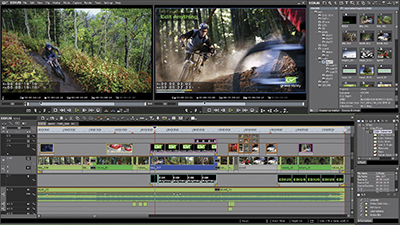New Editing Systems Upgrade for 4K

Jay Ankeney
As April’s NAB Show exhibit floor demonstrated, 4K is here in all its high-resolution glory. We can shoot it, distribute it, and display it; but how about editing it?
Last month we looked at three NLEs that can tackle a 4K workflow (Avid’s Media Composer, Autodesk’s Smoke and Sony Creative Software’s Vegas Pro). This month and next we’ll look at a spectrum of other edit systems valiantly climbing the 4K summit.
ADOBE
Al Mooney, product manager of video editing for Adobe, tells us that ever since Adobe Creative Suite 5 was released in May 2010, the Mercury Playback Engine supporting GPU-accelerated rendering in their Premiere Pro editing software has future-proofed its format capabilities.
Now, having moved their video post-production software to Adobe Creative Cloud a year ago, Premiere Pro has gained even more capabilities in the 4K realm.
Premiere Pro benefits from an Adobe concept called “fractional resolution” when editing with wavelet-based codecs like Red uses, which means even at half resolution, the whole 4K file can be read natively without transcoding. Then when the final master is rendered out, usually as a sequence of DPX images, it is built with 4K files from the original source.

Adobe President and Chief Executive Officer Shantanu Narayen discusses updates to Adobe Creative Cloud at Adobe MAX, The Creativity Conference, in May. “In fact, if needed, our systems could go beyond 9K,” Mooney said. “We’ve been working closely with Red Digital Cinema to ingest Red’s R3D files natively right from the beginning, and now, after the June 17 update of Adobe Creative Cloud, what is dubbed ‘Premiere Pro CC’ is also able to handle Sony’s XAVC files natively.”
The professional video industry's #1 source for news, trends and product and tech information. Sign up below.
Premiere Pro CC includes the Lumetri Deep Color Engine along with all-new versions of Adobe SpeedGrade CC, Audition CC, Prelude CC and Adobe Story CC Plus.
“In addition, since you need a rather robust workstation to handle 4K editing,” Mooney said, “we have given Premiere Pro CC support for more GPUs, including those from AMD and Nvidia on both Mac and Windows platforms.”
GRASS VALLEY
On July 8, Grass Valley released version 7 of their Edius software, which can now cut projects shot at 4K at 60p with Red’s R3D format, DPX sequences, Panasonic’s AVC-Ultra or several flavors of Sony’s XAVC, including XAVC Intra. Next year, it will be ready for XAVC Long-GOP when Sony releases its camcorder in 2014.
“Edius 7 supports any mix of SD, HD, 2K and 4K resolution on the timeline in real time,” said Atsushi (Alex) Kataoka, director of product management for Grass Valley. “Since Edius relies on a very open architecture, we call on CPU power to process the video. With more cores becoming available, it’s really just a matter of expanding our software’s capabilities.”
Edius does not support mastering in the digital cinema format (DCP), but can export in H.264 (mp4), QuickTime, and also in uncompressed YUV (.avi). Edius 7 supports a new workflow with DaVinci that would involve exchanging projects using an EDL to allow finishing the project in DaVinci and then exporting to DCP. However, Kataoka tells us the more common 4K workflow in Edius will be ingesting 4K files, but mastering in HD.
“This is facilitated by the region filter built into the Edius software that lets you select an area of the 4K video to use as an HD file,” Kataoka said. “We think this will be the mastering process used by productions originated in 4K for the near future.”
BORIS FX
Media 100 Suite v2 NLE software from Boris FX supports 4K and 2K video in 16:9 and 2:1 frame aspect ratios and at frame rates from 23.98 to 59.94 fps. This latest release has a special integration with Red’s R3D file format using Red Rocket acceleration, but needs other 4K files to be converted into a QuickTime format by a third-party software, according to Boris Yamnitsky, founder and CEO of Boris FX.

Version 7 of Grass Valley’s Edius supports any mix of SD, HD, 2K and 4K resolution on the timeline in real time. Media 100 Suite v2 includes a new metadata window that can manipulate metadata settings for R3D media, including color space, ISO speed and color temperature, although video clips of any size, standard and frame rate can be dropped into any program with automatic scaling and aspect ratio correction.
“Once they are ingested using Red Rocket acceleration, Media 100 editors can cut the 4K files directly,” Yamnitsky said. “Then you need to output in 4K using Red Rocket. Or, if they were ingested as QuickTime files, you can output in that format.”
Another handy feature is that Media 100 Suite’s Catch Frame window includes a pixel-accurate option that allows you to examine any image, even 4K video, at full size on a Mac monitor.
APPLE
Apple did not provide a spokesperson to be interviewed on the record, but their representative assured me that Final Cut Pro X is ready to handle 4K files natively as easily as it cuts HD. Once the 4K files are ingested, including Red Raw or Canon’s C500 Raw and with a free plug-in for Sony’s XAVC, FCP X’s ability to mix and match formats lets you put any resolution or frame size on its timeline.
The high-quality rescaler built into the FCP X software enables selecting specific areas of a 4K image if you want to use it in an HD production.
You can edit in Red Raw directly, or have FCP X automatically translate the files into Apple’s ProRes 4444 format that includes a mathematically lossless alpha channel for true 4:4:4:4 support. Of course, the AJA Ki Pro Quad recorder mentioned in last month’s column can translate many camera formats into ProRes and blast it into your edit system’s storage at 10 Gbps over a Thunderbolt connection.
There have even been projects edited with Red Raw natively on an Apple laptop with SSD storage, a high-quality graphics card and the visual enchantment of its retina display. You can find examples of projects shot on Red and edited in FCP X on the fcp.co website, and when Blackmagic Design releases its Blackmagic Production Camera this month, it will be recording its 4K images directly in ProRes.
As you would expect, whether laptop or desktop, you’ll need a powerful and up-to-date Apple computer to take advantage of FCP X’s native 4K capabilities, but that is true for any 4K editing system. If needed, Apple’s NLE easily lets you create 1/4-frame 1080 proxy files from any media in the background and those can even be edited on yesterday’s system. Then, once the project is finished, you link the proxies back to the original media and export the project in 4K.
Next month we’ll look at both the highest and lowest cost 4K editing systems.
Jay Ankeney is a freelance editor and post-production consultant based in Los Angeles. Write him atJayAnkeney@mac.com.
